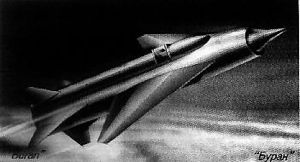
Home - Search - Browse - Alphabetic Index: 0- 1- 2- 3- 4- 5- 6- 7- 8- 9
A- B- C- D- E- F- G- H- I- J- K- L- M- N- O- P- Q- R- S- T- U- V- W- X- Y- Z
Buran RSS-52
 Buran missile M-42 and M-44 Buran trisonic ramjet missiles were considered in both manned and unmanned versions. Credit: Khrunichev |
AKA: RSS-52. Status: Cancelled 1957. Thrust: 104.00 kN (23,380 lbf). Gross mass: 50,000 kg (110,000 lb). Height: 28.00 m (91.00 ft). Diameter: 2.40 m (7.80 ft).
After the cancellation of the ground-launched version of the Buran missile, Myasishchev continued to pursue use of the M-42 cruise stage in aviation research and space exploration. In 1958 he appealed to both Khrushchev and Minister of Defence of Malinovskiy to support continued development. He now proposed an unmanned, air-launched version for high speed research.
At this time Myasishchev was developing the first Soviet supersonic bomber, the M-50. On the basis of this immense delta-winged vehicle Myasishchev proposed the RSS-52 aerospace vehicle. The RSS-52 would consist of the M-52 carrier aircraft, derived from the M-50. The M-52 would have an enormous recess in its fuselage, within which would be carried the M-44 ramjet. The M-44, designed by G D Dermichev, would be a derivative of the cancelled M-42. The M-52 would enter a circuit 1,000 km from base, accelerate to supersonic speed, and then launch the M-44. The M-44 would accelerate to hypersonic velocity, conduct a high speed run of an overwater circuit, and then splash down in the sea. A radio beacon would allow location and recovery of the craft.
In the United States, the X-15 was being developed to answer analogous questions. However due to the expense and technical problems, Myasishchev was unable to convince the leadership to approve the RSS-52.
Family: aircraft-launched, test vehicle. Country: Russia. Agency: Myasishchev bureau. Bibliography: 146, 189, 81, 83, 89.
1955 May 23 - . LV Family: Buran M. Launch Vehicle: Buran RSS-52.
- RS ramjet-powered Mach 3 intercontinental aircraft - . Nation: Russia. Related Persons: Tsybin. P V Tsybin's OKB-256 selected to build the RS ramjet-powered Mach 3 intercontinental reconnaissance/strike aircraft. The aircraft, air-launched from a Tu-95N bomber, was in competition with the V M Myasishchev (OKB-23) RSS-52 system..
1958 During the Year - . LV Family: Buran M. Launch Vehicle: Buran RSS-52.
- Myasishchev proposed use of the Buran M-42 cruise stage in aviation research - .
Nation: Russia.
Related Persons: Myasishchev.
Spacecraft Bus: Buran M.
Spacecraft: Buran M-44.
On the basis of the immense delta-winged M-50 bomber Myasishchev proposed the RSS-52 aerospace vehicle. The M-50 derivative would enter a circuit 1,000 km from base, accelerate to supersonic speed, and then launch the M-44. The M-44 would accelerate to hypersonic velocity, conduct a high speed run of an overwater circuit, and then splash down in the sea. In the United States, the X-15 was being developed to answer analogous questions. However due to the expense and technical problems, Myasishchev was unable to convince the leadership to approve the RSS-52.
Back to top of page
Home - Search - Browse - Alphabetic Index: 0- 1- 2- 3- 4- 5- 6- 7- 8- 9
A- B- C- D- E- F- G- H- I- J- K- L- M- N- O- P- Q- R- S- T- U- V- W- X- Y- Z
© 1997-2019 Mark Wade - Contact
© / Conditions for Use